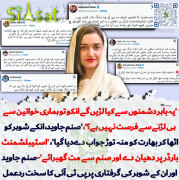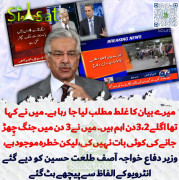mrcritic
Minister (2k+ posts)
A few days ago my childhood class-fellow from Bhopal, Dr Anwar Kamal Pasha, who is now a Saudi national, visited me. He went to Saudi Arabia in the mid-fifties and later opened a hospital in Jeddah. As happened with many Pakistanis, he was helped in getting Saudi nationality by another Pakistani, Dr Fazlur Rahman, who was royal physician to the late King Khaled bin Abdul Aziz al-Saud. Dr Pasha is a tall, handsome gentleman, a true copy of his father, Col Ibrahim Pasha of the Bhopal Army. Dr Pasha presented me an excellent book a book which is really a treasure of knowledge containing the secrets of Hazrat Zulqarnain (AS). It proved to be so interesting and absorbing that once I started reading it I could not put it down. I would like to share some of these secrets here. The name of the book is: Unlocking the Secrets of Dhul-Qarnayn and Yajouj and Majouj, and it is written by Mr Hamdi bin Hamza al-Suraiseri al-Johani, a Saudi scholar. It was published under the patronage of His Royal Highness Prince Salman bin Abdul Aziz al-Saud. May Allah Almighty shower His blessings on them and their families. Ameen.
The story of Zulqarnain (AS) has been mentioned by Allah in Para 15, Surah Kahf, Ayats 83-100 in the following words:
(O Muhammad), they ask you about Dhul-Qarnayn. Say: I will give you an account of him. We granted him power in the land and endowed him with all kinds of resources. He set out (westwards) on an expedition until, when he reached the very limits where the sun sets, he saw it setting in dark, turbid waters and nearby he met a people. We said: O Dhul-Qarnayn, you have the power to punish or to treat them with kindness. He said: We will chastise him who does wrong, whereafter he will be returned to his Lord and He will chastise him grievously. But as for him who believes and acts righteously, his will be a goodly reward and we shall enjoin upon him only mild commands. Then he set out on another expedition until he reached the limit where the sun rises and he found it rising on a people whom We had provided no shelter from it. Thus was the state of those people, and We encompassed in knowledge all concerning Dhul-Qarnayn. Then he set out on another expedition until when he reached a place between the two mountains, he found beside the mountains a people who scarcely understood anything. They said: O Dhul-Qarnayn, Gog and Magog are spreading corruption in this land. So shall we pay you taxes on the understanding that you will set up a barrier between us and them? He answered: Whatever my Lord has granted me is good enough. But help me with your labour and I will erect a rampart between you and them. Bring me ingots of iron. Then after he had filled up the space between the two mountainsides, he said: (Light a fire) and ply bellows. When he had made it (red like) fire, he said: Bring me molten lead which I may pour on it. So high was the rampart that Gog and Magog could not scale it, nor could they pierce it because of the strength of the structure. Dhul-Qarnayn said: This is a mercy from my Lord: but when the time of my Lords promise shall come, He will level the rampart with the ground. My Lords promise always comes true. And on that Day We shall let some of them surge like waves against others, and the Trumpet shall be blown. Then We shall gather them all together. That will be the Day We shall place Hell before the unbelievers.
Only in one more place (Surah Anbiyaa) has Almighty Allah mentioned Yajouj and Majouj (Gog and Magog). There he used the following words about them: But there is a ban on any population which We have destroyed, that they shall not return until the Gog and Magog are let through and they swiftly swarm from every hill.
The author has given rather convincing arguments that earth from a nearby site was used and that that earth contained many minerals. These melted as they were poured onto the hot iron pieces, turning the rampart into a compact, solid and impenetrable mass.
Syed Abul Aala Maudoodi, in his explanation of the Holy Quran, titled Tafhimul Quran, a book which is beautifully translated into English by Dr Zafar Ishaq Ansari, mentioned that Yajouj and Majouj were wild, ferocious marauders living in north-eastern Asia (present-day Nongolia and China). They used to raid inhabited areas, killing and looting as they went. They were also known as the Horse People and were probably the Mongols. Some historians thought that these people lived in the area north of the Black Sea while others thought they lived east of what is now Moscow, the capital of Russia.
Mr Mukhtar Masood mentioned in his very interesting book titled Lauh-e-Ayyam that the Iranians thought that Zulqarnain (AS) was Cyrus the Great, which is not a possibility in view of historical facts. Mr Masood was a very able civil servant whom I used to meet on PIA flights to London which, in those days, made a stopover in Tehran on the way. However, Pakistani passengers were not allowed to disembark in the Iranian capital, which annoyed and frustrated us. The Shah of Iran, who met his downfall in 1979, traced his ancestors back to Cyrus the Great and celebrated 2,500 years of the Pehlavi Dynasty in 1971, spending almost $800 million on the grandiose event. Yahya Khan attended the celebrations and caused embarrassment by drinking too much liquor and then wetting his pants. Brig Amir Gulistan Janjua, his military secretary, was prompt in dealing with the embarrassment. He accidentally spilled a glass of cold drink on Yahya Khan and took him away, all the while apologising profusely for the mishap. Brig Janjua, later lieutenant general, went on to become Pakistans ambassador to Saudi Arabia and, at the end of 1988, governor of the North-West Frontier Province, which is now Khyber-Pakhtunkhwa.
The extensive and thorough research carried out over many years by Mr Hamdi bin Hamza has negated all claims that Hazrat Zulqarnain (AS) was either Alexander the Great, as many people assume, or Cyrus the Great. As Almighty Allah explained in the Quran, Hazrat Zulqarnain (AS) was a prophet sent by Allah and it was he who had travelled to the places where the sun rose and where the sun set. It was he who erected a rampart or barrier in China to protect the inhabitants from the marauding Mongols. Those mentioned as Yajouj and Majouj were Mongols.
In the second part of this article I will discuss some of the fascinating details of the research done by Mr Hamdi bin Hamza al-Suraiseri al-Johani.
(To be continued)

Source
The story of Zulqarnain (AS) has been mentioned by Allah in Para 15, Surah Kahf, Ayats 83-100 in the following words:
(O Muhammad), they ask you about Dhul-Qarnayn. Say: I will give you an account of him. We granted him power in the land and endowed him with all kinds of resources. He set out (westwards) on an expedition until, when he reached the very limits where the sun sets, he saw it setting in dark, turbid waters and nearby he met a people. We said: O Dhul-Qarnayn, you have the power to punish or to treat them with kindness. He said: We will chastise him who does wrong, whereafter he will be returned to his Lord and He will chastise him grievously. But as for him who believes and acts righteously, his will be a goodly reward and we shall enjoin upon him only mild commands. Then he set out on another expedition until he reached the limit where the sun rises and he found it rising on a people whom We had provided no shelter from it. Thus was the state of those people, and We encompassed in knowledge all concerning Dhul-Qarnayn. Then he set out on another expedition until when he reached a place between the two mountains, he found beside the mountains a people who scarcely understood anything. They said: O Dhul-Qarnayn, Gog and Magog are spreading corruption in this land. So shall we pay you taxes on the understanding that you will set up a barrier between us and them? He answered: Whatever my Lord has granted me is good enough. But help me with your labour and I will erect a rampart between you and them. Bring me ingots of iron. Then after he had filled up the space between the two mountainsides, he said: (Light a fire) and ply bellows. When he had made it (red like) fire, he said: Bring me molten lead which I may pour on it. So high was the rampart that Gog and Magog could not scale it, nor could they pierce it because of the strength of the structure. Dhul-Qarnayn said: This is a mercy from my Lord: but when the time of my Lords promise shall come, He will level the rampart with the ground. My Lords promise always comes true. And on that Day We shall let some of them surge like waves against others, and the Trumpet shall be blown. Then We shall gather them all together. That will be the Day We shall place Hell before the unbelievers.
Only in one more place (Surah Anbiyaa) has Almighty Allah mentioned Yajouj and Majouj (Gog and Magog). There he used the following words about them: But there is a ban on any population which We have destroyed, that they shall not return until the Gog and Magog are let through and they swiftly swarm from every hill.
The author has given rather convincing arguments that earth from a nearby site was used and that that earth contained many minerals. These melted as they were poured onto the hot iron pieces, turning the rampart into a compact, solid and impenetrable mass.
Syed Abul Aala Maudoodi, in his explanation of the Holy Quran, titled Tafhimul Quran, a book which is beautifully translated into English by Dr Zafar Ishaq Ansari, mentioned that Yajouj and Majouj were wild, ferocious marauders living in north-eastern Asia (present-day Nongolia and China). They used to raid inhabited areas, killing and looting as they went. They were also known as the Horse People and were probably the Mongols. Some historians thought that these people lived in the area north of the Black Sea while others thought they lived east of what is now Moscow, the capital of Russia.
Mr Mukhtar Masood mentioned in his very interesting book titled Lauh-e-Ayyam that the Iranians thought that Zulqarnain (AS) was Cyrus the Great, which is not a possibility in view of historical facts. Mr Masood was a very able civil servant whom I used to meet on PIA flights to London which, in those days, made a stopover in Tehran on the way. However, Pakistani passengers were not allowed to disembark in the Iranian capital, which annoyed and frustrated us. The Shah of Iran, who met his downfall in 1979, traced his ancestors back to Cyrus the Great and celebrated 2,500 years of the Pehlavi Dynasty in 1971, spending almost $800 million on the grandiose event. Yahya Khan attended the celebrations and caused embarrassment by drinking too much liquor and then wetting his pants. Brig Amir Gulistan Janjua, his military secretary, was prompt in dealing with the embarrassment. He accidentally spilled a glass of cold drink on Yahya Khan and took him away, all the while apologising profusely for the mishap. Brig Janjua, later lieutenant general, went on to become Pakistans ambassador to Saudi Arabia and, at the end of 1988, governor of the North-West Frontier Province, which is now Khyber-Pakhtunkhwa.
The extensive and thorough research carried out over many years by Mr Hamdi bin Hamza has negated all claims that Hazrat Zulqarnain (AS) was either Alexander the Great, as many people assume, or Cyrus the Great. As Almighty Allah explained in the Quran, Hazrat Zulqarnain (AS) was a prophet sent by Allah and it was he who had travelled to the places where the sun rose and where the sun set. It was he who erected a rampart or barrier in China to protect the inhabitants from the marauding Mongols. Those mentioned as Yajouj and Majouj were Mongols.
In the second part of this article I will discuss some of the fascinating details of the research done by Mr Hamdi bin Hamza al-Suraiseri al-Johani.
(To be continued)

Source




























